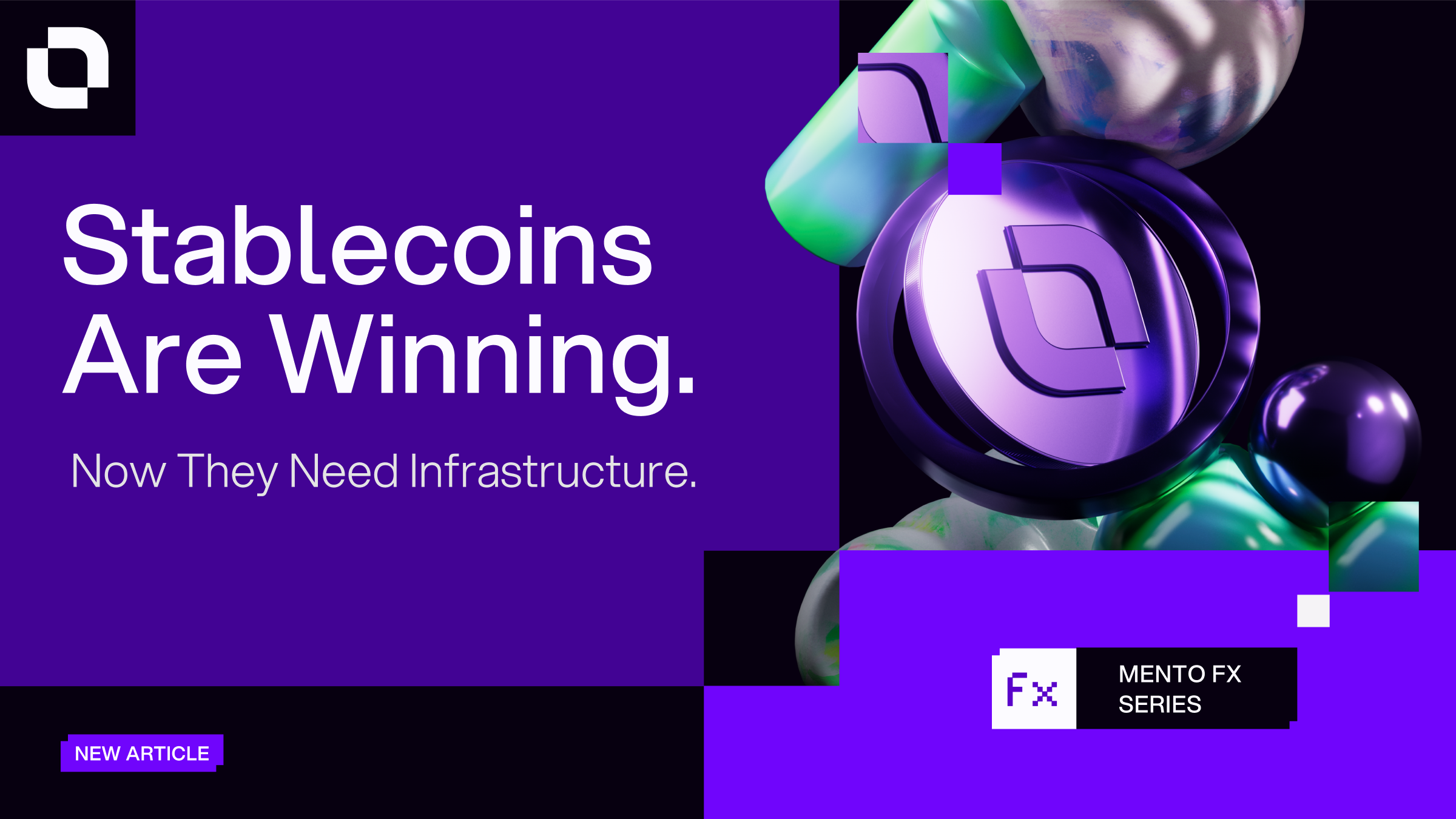Stablecoins Are Winning. Now They Need Infrastructure.

Stablecoins aren’t theoretical anymore. In Q1 2025, they processed over $14 trillion in onchain transactions. Market capitalization crossed $250 billion, and stablecoins now dominate crypto payment volume, DeFi collateral, and cross border settlement.
But the tools to actually use them across borders, currencies, and applications remain underdeveloped. Stablecoins work. The system around them does not.
That’s where Mento comes in.
Stablecoins Outpaced the System That Birthed Them
Stablecoins were built for traders. Most early infrastructure was optimized for moving USDC or USDT between exchanges. But their reach has expanded far beyond that. Today, stablecoins are used for:
- Remittances
- Merchant payments
- Savings in unstable economies
- Payroll for freelancers
- Treasury management by fintechs
- Microloans and humanitarian aid
Each of these use cases demands stability and mobility; users don’t just need to hold value, they need to move between currencies. They need real-time FX (Foreign Exchange). They need swaps that don’t bleed value. They need composability across chains and apps. The problem is, that infrastructure barely exists.
Five Gaps Holding Back Stablecoin Utility
1. Currency Fragmentation
The vast majority of stablecoin liquidity remains USD denominated. If you live in Colombia, Nigeria, or the Philippines, you often need to use a Dollar pegged token, then cash out into your local currency. That double hop creates slippage, fees, and friction. Local stablecoins exist, but they’re scattered and illiquid.
Mento solves this with a full suite of local and global fiat-pegged decentralized stablecoins including cUSD, cKES, cCOP, cREAL, and more launched with reliable collateral and real-world use in mind.
2. Missing FX Logic
There’s no native infrastructure for converting one stablecoin to another at real-world FX rates. DeFi AMMs weren’t designed for currency markets. They float pairs without anchoring to external FX rates, creating unstable pricing and unnecessary volatility.
Mento is building Fixed Price Market Makers (FPMMs), a mechanism specifically designed to track real FX rates, enabling stablecoin swaps with low slippage and consistent pricing.
3. Chain Silos
Stablecoins are deployed across dozens of chains, but conversion paths and liquidity often stay isolated. USDT on Tron doesn't easily interact with USDC on Ethereum, let alone local currency stablecoins on a Celo compatible wallet.
Mento’s multi-chain infrastructure spans EVM and non EVM chains, with an architecture designed for cross chain liquidity access and composable integrations.
4. No Native Minting/Redemption Across Currencies
Many users in emerging markets can receive stablecoins but cannot mint, redeem, or swap them directly onchain. They’re stuck depending on centralized exchanges, OTC desks, or cash intermediaries.
Mento's CDP system introduces stablecoin launch tied to collateral, giving the community control over minting, stability, and risk without reliance on third parties.
5. FX Still Runs on Closed Banking Rails
Despite stablecoin growth, actual currency exchange between fiat-pegged tokens often still requires off-chain action. Cross-border payroll, savings, or credit are slowed by FX markets that only operate on weekdays, 9–5, with 2–5 day settlement times and multiple intermediaries.
Mento treats FX as a protocol 24/7, always-on programmable system that anyone can integrate into apps, wallets, or DAOs.
Why This Matters Now
Stablecoins are reaching people who don’t have traditional bank access. They’re used by workers who need to send money across borders, by businesses that pay suppliers in other currencies, and by developers who build new financial tools for mobile-native economies.
But without infrastructure, every transaction still depends on:
- Manual currency conversion
- Price quotes from external oracles
- Bridging assets across networks
- Spreads from legacy FX markets
- Off-chain KYC choke points
That’s not a financial system. It is a patchwork.
Mento is building a coordinated, modular system that lets any app handle money in any currency, all onchain, with native pricing, minting, and movement.
What the Infrastructure Looks Like
- 15+ fiat stablecoins with live usage across Africa, Latin America, and Southeast Asia
- Fixed price FX pairs that reflect market exchange rates
- Community-run governance and treasury tools for risk control
- Chain-agnostic deployment, so builders can tap into liquidity wherever they operate
- Integrated into apps like MiniPay and Squid Router, powering real payments
This isn’t a protocol sitting idle. Mento processed over 550 million transactions in 2024, serving more than 8 million users. It's already being used to swap, save, and spend across borders.
Stablecoins Don’t Need More Hype. They Need Functionality.
The stablecoin story doesn’t hinge on one more billion in volume. That part is already proven.
The next phase depends on infrastructure real systems that make stablecoins useful in local economies, global payments, and everyday apps.
That’s the layer Mento is building.
If you’re building apps in emerging markets, if you need FX liquidity, or if you're designing a system that requires stable, local currency onchain, this is the protocol to build on.
Stablecoins are here. The infrastructure to make them usable is next.
Mento is ready.
Join the Mento Community I Explore Mento Documentation I Contact the Mento Team












.avif)

.avif)
.avif)
.avif)
.avif)
.avif)
